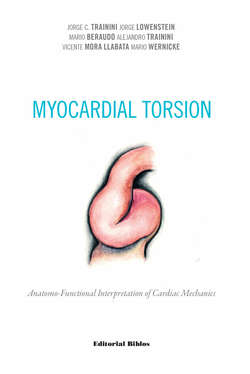Читать книгу Myocardial Torsion - Jorge C. Trainini - Страница 9
2. Myocardial architecture
ОглавлениеLeft ventricle. The entire apex belongs to the left ventricle. In the distal part of the left ventricle, called apical, a muscle layer with spiral trajectory extends from the surface to the center and undergoes a rotation that turns the subepicardial fibers into subendocardial fibers, overlapping like the tiles of a roof. Consequently, the left ventricular distal end, the apex, surrounds a virtual conduit with no muscular plane at its ultimate end, lined internally by the endocardium and externally by the epicardium, with no intermediary muscle. It is essential to consider that in the apex the fibers undergo a helical rotational motion with sphincter-like arrangement as they transform from subepicardial to subendocardial fibers, following a clockwise trajectory (apical view of the diaphragmatic surface of the heart in the anatomical position) (Figures 1.5 and 1.6). (105)
Figure 1.5. Apical view of the left and right ventricles.
Figure 1.6. Spiral arrangement of apical muscle layers.
In the left ventricular basal half, at the level of its free wall (Figure 1.7), the fibers are arranged similarly to the apical half. A muscle layer with spiral trajectory extends from the surface to the center displaying its fibers from outside to inside (from paraepicardial to paraendocardial regions). At this level their orientation is opposite to that of the apex, following a counter-clockwise trajectory (apical view of the diaphragmatic surface of the heart in anatomical position). This arrangement of the muscle layer in its twist limits a cavity which at the base of the heart is real and not virtual as in the apex.
Figure 1.7. Basal third of the left ventricle.
It depicts the muscle layers of the free wall.
The apex should be considered as a tunnel with a muscular rim surrounding its entire ring, while at the ventricular base this ring has two parts. One part corresponds to the left ventricular free wall and the other to the interventricular septum. In addition, the most superficial basal fibers make contact with the fibrous mitral annulus, a setting that is absent at the apical level. Nevertheless, the essential functional difference between basal and apical regions is their opposite fiber motion. This characteristic determines myocardial torsion to achieve cardiac blood ejection and the untwisting that generates suction and diastolic filling.
Right ventricle. Theoretically, two types of fibers can be identified in its distal half according to their orientation: paraendocardial and paraepicardial fibers. The former extend from the pulmonary base backwards and downwards to the apical region, whereas the others extend from the anterior interventricular sulcus to the back approaching the base of the heart. This X-shaped crossover arrangement allows the fibers in the distal end of the right ventricle to adopt a helical arrangement, turning from subepicardial to subendocardial (Figure 1.8).
Figure 1.8. Right ventricular free wall.
Three segments can be identified at the basal half of the right ventricle (tricuspid orifice perimeter): free wall, supraventricular crest and interventricular septum. The free wall presents the same general configuration of spiraling fibers that extend from subepicardial to subendocardial positions. Similarly to the left ventricle, there is a difference in the rotating sense of the basal fibers with respect to the distal ones. They follow a counterclockwise trajectory at the basal end and a clockwise trajectory at the distal end (apical view of the diaphragmatic surface of the heart in anatomical position).
The comparison of the rope model (Figure 1.4) with the ventricular apical and basal regions (Figure 1.1) shows the analogy existing between the rope configuration and the myocardial fibers.
